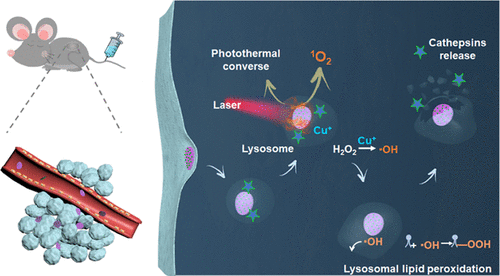当前位置:
X-MOL 学术
›
ACS Appl. Mater. Interfaces
›
论文详情
Our official English website, www.x-mol.net, welcomes your
feedback! (Note: you will need to create a separate account there.)
Near-Infrared-Activated Lysosome Pathway Death Induced by ROS Generated from Layered Double Hydroxide-Copper Sulfide Nanocomposites.
ACS Applied Materials & Interfaces ( IF 8.3 ) Pub Date : 2020-08-13 , DOI: 10.1021/acsami.0c11739 Chen-Guang Liu 1, 2 , Han-Xiao Tang 1, 2 , Xiang Zheng 1, 2 , Da-Yun Yang 3 , Yang Zhang 4 , Jian-Ting Zhang 1, 2 , Ranjith Kumar Kankala 1, 2 , Shi-Bin Wang 1, 2 , Gang Liu 4 , Ai-Zheng Chen 1, 2
ACS Applied Materials & Interfaces ( IF 8.3 ) Pub Date : 2020-08-13 , DOI: 10.1021/acsami.0c11739 Chen-Guang Liu 1, 2 , Han-Xiao Tang 1, 2 , Xiang Zheng 1, 2 , Da-Yun Yang 3 , Yang Zhang 4 , Jian-Ting Zhang 1, 2 , Ranjith Kumar Kankala 1, 2 , Shi-Bin Wang 1, 2 , Gang Liu 4 , Ai-Zheng Chen 1, 2
Affiliation

|
The overdeveloped lysosomes in cancer cells are gaining increasing attention toward more precise and effective organelle-targeted cancer therapy. It is suggested that rod/plate-like nanomaterials with an appropriate size exhibited a greater quantity and longer-term lysosomal enrichment, as the shape plays a notable role in the nanomaterial transmembrane process and subcellular behaviors. Herein, a biodegradable platform based on layered double hydroxide-copper sulfide nanocomposites (LDH-CuS NCs) is successfully prepared via in situ growth of CuS nanodots on LDH nanoplates. The as-prepared LDH-CuS NCs exhibited not only high photothermal conversion and near-infrared (NIR)-induced chemodynamic and photodynamic therapeutic efficacies, but also could achieve real-time in vivo photoacoustic imaging (PAI) of the entire tumor. LDH-CuS NCs accumulated in lysosomes would then generate extensive subcellular reactive oxygen species (ROS) in situ, leading to lysosomal membrane permeabilization (LMP) pathway-associated cell death both in vitro and in vivo.
中文翻译:

由层状双氢氧化物-铜-硫化铜纳米复合材料产生的ROS引起的近红外激活的溶酶体途径死亡。
癌细胞中溶酶体的过度开发正日益引起人们对更精确和有效的针对细胞器的癌症治疗的关注。建议具有适当尺寸的棒/板状纳米材料表现出更大的数量和长期的溶酶体富集,因为形状在纳米材料跨膜过程和亚细胞行为中起着显著作用。本文中,通过在LDH纳米板上原位生长CuS纳米点,成功地制备了基于层状双氢氧化物-硫化铜纳米复合材料(LDH-CuS NCs)的可生物降解平台。所制备的LDH-CuS NCs不仅显示出高的光热转化率和近红外(NIR)诱导的化学动力学和光动力学治疗效果,而且还可以实现整个肿瘤的实时体内光声成像(PAI)。
更新日期:2020-09-10
中文翻译:

由层状双氢氧化物-铜-硫化铜纳米复合材料产生的ROS引起的近红外激活的溶酶体途径死亡。
癌细胞中溶酶体的过度开发正日益引起人们对更精确和有效的针对细胞器的癌症治疗的关注。建议具有适当尺寸的棒/板状纳米材料表现出更大的数量和长期的溶酶体富集,因为形状在纳米材料跨膜过程和亚细胞行为中起着显著作用。本文中,通过在LDH纳米板上原位生长CuS纳米点,成功地制备了基于层状双氢氧化物-硫化铜纳米复合材料(LDH-CuS NCs)的可生物降解平台。所制备的LDH-CuS NCs不仅显示出高的光热转化率和近红外(NIR)诱导的化学动力学和光动力学治疗效果,而且还可以实现整个肿瘤的实时体内光声成像(PAI)。


















































 京公网安备 11010802027423号
京公网安备 11010802027423号